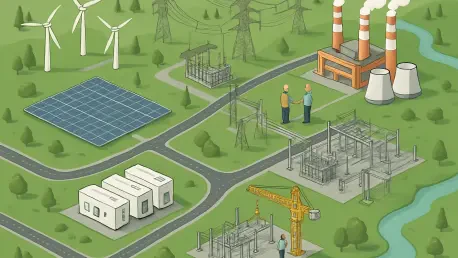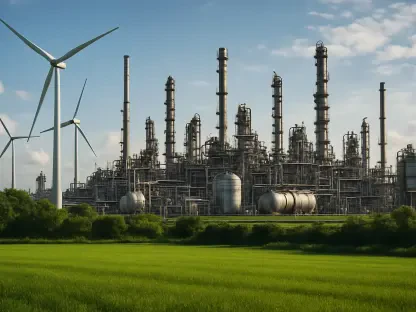Imagine a sprawling region across North America, home to millions, where the lights flicker under the strain of surging energy demands and an aging grid. This is the reality for the Midcontinent Independent System Operator (MISO), a key player responsible for managing electricity transmission across multiple states and parts of Canada. With reliability concerns mounting, MISO has launched an ambitious initiative to bolster grid stability through the rapid integration of new power projects. This roundup dives into diverse perspectives from industry stakeholders, analysts, and regional authorities to explore how MISO’s Expedited Resource Addition Study (ERAS) program is shaping the future of energy security. By gathering insights on project proposals, energy mixes, and regional strategies, this piece aims to illuminate the multifaceted approach to tackling urgent grid challenges.
Unpacking MISO’s Push for a Stronger Energy Network
MISO oversees a vast grid that powers homes and industries across a wide footprint, facing unprecedented pressure from rising demand and evolving energy needs. The ERAS program stands out as a critical mechanism to fast-track the interconnection of new generation resources, targeting projects that can come online within three to six years. Industry observers note that this initiative is a direct response to immediate reliability gaps, emphasizing the urgency of adding capacity to prevent potential outages.
Beyond the technical framework, many energy analysts highlight the strategic importance of this program in an era of transitioning power sources. The focus isn’t just on adding megawatts but on ensuring a stable supply amidst changing consumption patterns and retiring older plants. Discussions among utility planners often center on how MISO’s efforts could set a precedent for other grid operators grappling with similar issues.
A recurring theme in stakeholder conversations is the balance between speed and sustainability. While the need for quick solutions drives the ERAS program, there’s a palpable concern among environmental advocates about the long-term implications of the chosen energy mix. This roundup will explore these tensions by examining varied opinions on MISO’s proposed projects, regional differences, and the broader impact on grid resilience.
Exploring the ERAS Program and Proposed Power Solutions
Gas-Fired Power Leading the Charge for Quick Fixes
A striking consensus among industry watchers is the dominance of gas-fired generation in MISO’s ERAS proposals, accounting for roughly 19,700 MW out of a total 26,575 MW of capacity. Many utility representatives argue that natural gas offers a proven, rapid-deployment option to address pressing reliability needs, especially in a timeframe as short as three years. This perspective underscores the practicality of leveraging existing infrastructure for immediate grid support.
However, not all stakeholders are aligned on this heavy reliance. Environmental groups frequently point out the carbon footprint associated with such a gas-centric approach, cautioning that it could lock in emissions for decades. Their critique often focuses on the missed opportunity to prioritize cleaner alternatives, even if those alternatives require more time or investment to scale.
Analysts also weigh in with a pragmatic view, noting that while gas projects dominate with about three-quarters of the proposed capacity, they serve as a necessary bridge during this transition period. The debate remains heated over whether this reliance might hinder progress toward decarbonization goals, with some suggesting that MISO could face regulatory pushback if sustainability isn’t better integrated into future plans.
Energy Storage and Renewables Gaining Ground in Modernization Efforts
Shifting to cleaner technologies, many industry voices are enthusiastic about the 4,000 MW of energy storage proposals, representing 15% of the total capacity under ERAS. Utility planners often emphasize storage as a game-changer for balancing intermittent renewable sources, with regions like Minnesota showcasing a robust 1,250 MW of storage projects alongside smaller solar and wind contributions. This mix is seen as a forward-thinking step in grid modernization.
Yet, challenges persist, as some technical experts caution that storage technologies, while promising, face hurdles in scalability and cost-effectiveness for near-term demands. Their assessments suggest that while storage can stabilize renewable output, the infrastructure and funding required might not align with the urgent timelines MISO has set. This creates a divide between optimism for future potential and realism about current limitations.
Renewable energy advocates, meanwhile, applaud the inclusion of solar (4%) and wind (4.5%) projects in the mix, viewing them as essential for long-term sustainability. Though these percentages are modest, supporters argue that even small strides in renewables signal a shift in mindset. The question remains whether MISO can accelerate these technologies without compromising the immediate reliability goals at the core of the ERAS initiative.
Nuclear Energy’s Subtle Return and New Possibilities
An unexpected point of discussion is the inclusion of a 675-MW nuclear project in Iowa, comprising just 2.5% of the total proposed capacity. Several energy policy analysts see this as a symbolic nod to nuclear power’s potential as a low-carbon baseload option, especially in a landscape hungry for clean, consistent energy. This small but notable proposal has sparked renewed interest in nuclear’s role within MISO’s strategy.
Regional disparities add complexity to this narrative, with some state-level authorities in areas like Louisiana focusing almost entirely on gas, while others, such as Minnesota, explore a broader mix. Opinions differ on nuclear’s viability, with skeptics highlighting high costs and lengthy development timelines as barriers to wider adoption. They argue that such projects might not align with the fast-track nature of ERAS.
Proponents of nuclear energy, however, counter that technological advancements and shifting public attitudes could reposition it as a cornerstone for decarbonization. Their perspective challenges conventional thinking, suggesting that even a minor presence in current proposals might pave the way for larger investments down the line. This debate underscores a broader curiosity about whether nuclear can carve out a significant space in MISO’s evolving energy framework.
Regional Differences Influencing MISO’s Energy Strategy
Diverse opinions emerge when examining how localized needs shape MISO’s project distribution. In Louisiana, for instance, stakeholders often justify the focus on 6,170 MW of gas-fired projects due to industrial demand and existing pipeline networks. Regional energy planners argue that such a strategy ensures quick reliability gains tailored to specific economic priorities.
Contrastingly, in Indiana, a blend of 4,100 MW in gas and 1,470 MW in storage reflects a hybrid approach, with state regulators often cited as pushing for innovation alongside stability. This balance garners praise from some analysts who see it as a model for integrating modern solutions without abandoning proven resources. Their insights suggest that state policies play a pivotal role in shaping project types.
Minnesota’s diverse portfolio, including significant storage and renewables, draws attention from clean energy advocates who view it as a blueprint for progressive grid planning. Discussions with regional authorities often reveal a strong policy emphasis on sustainability, influencing a more varied energy mix. These contrasting regional strategies fuel a larger conversation about how localized approaches within MISO’s footprint might inform national grid policies over time.
Key Takeaways from MISO’s Rapid Response Efforts
Synthesizing the range of perspectives, a clear picture emerges of MISO’s ERAS program as a multifaceted endeavor. Industry consensus points to the 26.6 GW of proposals being heavily weighted toward gas-fired generation, seen as a practical solution for urgent needs. Meanwhile, storage’s substantial 4,000 MW share earns recognition from many as a vital component for future grid flexibility.
Utility leaders and policymakers often stress the importance of learning from this initiative to balance short-term reliability with sustainable growth. Their advice frequently centers on fostering collaboration between regulators and energy providers to ensure that investments in storage and renewables keep pace with fossil fuel projects. This dual focus is seen as critical for avoiding long-term environmental setbacks.
Another recurring tip from energy consultants is the need for transparency in tracking ERAS outcomes, allowing stakeholders to assess whether the program meets its reliability targets without sidelining clean energy goals. For those keen to dive deeper, engaging with regional energy forums or following MISO’s quarterly study updates offers a way to stay informed about evolving trends and policy shifts.
Reflecting on MISO’s Grid Reliability Journey
Looking back, MISO’s fast-track initiative through the ERAS program stood as a pivotal moment in addressing grid reliability amidst growing energy demands. The blend of gas-heavy proposals with emerging storage and renewable projects highlighted a pragmatic yet complex path that sparked rich dialogue among stakeholders. Regional variations further enriched this narrative, showcasing how tailored strategies could meet diverse needs within a unified framework.
Moving forward, the insights gathered pointed to actionable steps like prioritizing funding for scalable storage solutions and advocating for policies that incentivize renewable integration. Exploring partnerships to revisit nuclear energy’s potential also emerged as a consideration for achieving low-carbon baseload power. These steps offered a roadmap for not just MISO, but other grid operators, to navigate the delicate balance between immediate stability and a sustainable energy future.









